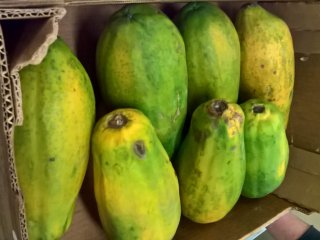
Research Results
Anti-fungal treatments to reduce mould development in papaya
In the GreenCHAINge project research focus was on getting a better grip on mould prevention at papaya to get high-quality and ready-to-enjoy fruits for consumers. This research result describes which anti-fungal treatments can be used to reduce mould development at papaya.

Objective
To ensure high quality papayas in the supermarkets, it is important to understand how mould growth can be prevented. The objective of this research was to determine the effects of packaging papayas and heat treatments of papayas on mould development.
The aim is to allow for transport of papayas oversees, instead of by air transport, without losing quality of the product. This has both economic and environmental advantages.
The experiment
During the study, 200 papayas were transported from Brazil to the Netherlands under different conditions: packed and unpacked, CA and non-CA, heat-treated and not heat-treated. The hydration status and mould levels were measured to determine the effects of these conditions.
- The measurements indicated that packed papayas had a 0.5% higher moisture content, and reduced mould on both stem and fruit compared to unpacked papayas.
- Papayas stored for 16 days in CA were less dehydrated, but had similar levels of mould, compared to papayas that had not been stored in CA.
- Heat-treated papayas showed less fruit mould when treated at 49°C for 5 minutes, and less stem mould when treated at 49°C for 30 minutes.

Conclusion
Heat treatment of papayas seems to have potential in reducing the developments of mould. Particularly the application of the water bath, which is already in use to export papayas from Brazil to the US to destroy insects, could be applied “fast/easy” to prevent mould development long distance export (2-3 week transport oversees) to Europe.